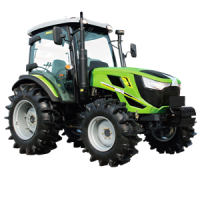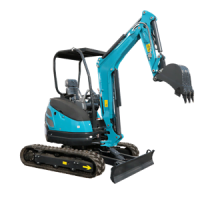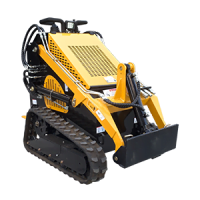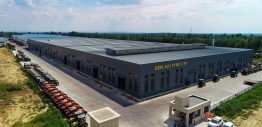Difference Between Excavator and Backhoe.Excavators and backhoes are two heavy machinery types often used in construction and excavation projects. They serve distinct purposes and come with specific features that cater to various job requirements. In this article, we will explore the differences between excavators and backhoes to help you understand which machine is best suited for your specific needs.
What Is an Excavator?

Definition and Purpose
An excavator, often referred to as a digger or mechanical shovel, is a heavy construction machine with a specific focus on digging, excavation, and material movement. These robust machines are designed to efficiently and precisely remove soil, rocks, debris, and other materials from one location and deposit them elsewhere. The primary purpose of an excavator is to facilitate various earthmoving tasks in construction, mining, and excavation projects.
Excavators are equipped with a rotating operator’s cab, a hydraulic arm, a boom, and a bucket attachment. These components work in harmony to provide unparalleled digging capabilities. The hydraulic system within the excavator allows the operator to control the arm and bucket with precision, making it an invaluable tool for tasks requiring accuracy and depth.
The excavator’s versatility in digging trenches, excavating foundations, and clearing land cannot be overstated. Its impressive reach and depth make it a key player in projects that demand the excavation of deep holes, precise shaping of landscapes, and the removal of substantial volumes of earth and debris.
Key Features
- Rotating Cab: The operator’s cabin can rotate 360 degrees, providing excellent visibility and maneuverability.
- Hydraulic Arm: The hydraulic arm and bucket allow for precise and powerful digging capabilities.
- Large Tracks or Wheels: Excavators have either tracks or wheels, ensuring stability on various terrains.
What Is a Backhoe?
Definition and Purpose
Excavators, renowned for their exceptional digging and excavation capabilities, boast a range of key features that set them apart as indispensable machines in the construction and heavy equipment industry:
- Rotating Cab: Excavators are equipped with a 360-degree rotating cab, providing the operator with unmatched visibility and maneuverability. This feature enables the operator to access hard-to-reach areas with ease and precision. The ability to rotate the cab is particularly valuable when working in confined spaces or along busy construction sites, enhancing safety and efficiency.
- Hydraulic Arm: At the core of an excavator’s functionality is its hydraulic arm. This hydraulic system empowers the operator to control the arm’s movement with precision and power. The hydraulic arm, often equipped with multiple joints, allows for intricate and controlled excavation, making it the ideal choice for projects that require exacting digging, trenching, and material removal.
- Large Tracks or Wheels: Excavators are available in various configurations, featuring either tracks or wheels. The choice between tracks or wheels depends on the specific application and terrain. Tracks provide stability and traction on uneven or soft ground, while wheeled excavators are favored for projects on solid and paved surfaces. This adaptability ensures that excavators can tackle a wide range of job sites with ease.
- Bucket Attachments: Excavators are typically equipped with a diverse array of bucket attachments. These buckets come in various shapes and sizes, each designed for a specific task. Common bucket types include digging buckets, grading buckets, and cleanup buckets. The versatility of these attachments allows excavators to excel in tasks ranging from digging trenches to handling materials like soil, gravel, and debris.
- Boom Configuration: Excavators come with a variety of boom configurations to suit different project requirements. Long-reach booms are ideal for deep excavation, while standard booms offer a balance of reach and maneuverability. Mini-excavators, with their compact design, are often equipped with shorter booms, making them suitable for tight spaces. The availability of these boom options ensures that excavators can be tailored to the demands of the job at hand.
- Advanced Controls: Excavators are equipped with state-of-the-art control systems that empower operators to manipulate the machine with precision. These controls allow for fine adjustments of the arm and bucket movements, enabling the operator to perform intricate tasks efficiently. Some modern excavators even feature computer-assisted controls and GPS technology to enhance accuracy and productivity.
- Safety Features: Safety is a paramount concern in the construction industry, and excavators are equipped with various safety features to mitigate risks. These may include overload warning systems, backup cameras, and reinforced cab structures. Operators are also trained to follow strict safety protocols to ensure accident-free operation.
- Maintenance Accessibility: Excavators are designed with maintenance in mind, with features such as easily accessible service points and hinged panels for quick inspection and repairs. Regular maintenance is crucial to keep the machine operating at peak performance and to extend its service life.
Key Features
Excavators, renowned for their exceptional digging and excavation capabilities, boast a range of key features that set them apart as indispensable machines in the construction and heavy equipment industry:
- Rotating Cab: Excavators are equipped with a 360-degree rotating cab, providing the operator with unmatched visibility and maneuverability. This feature enables the operator to access hard-to-reach areas with ease and precision. The ability to rotate the cab is particularly valuable when working in confined spaces or along busy construction sites, enhancing safety and efficiency.
- Hydraulic Arm: At the core of an excavator’s functionality is its hydraulic arm. This hydraulic system empowers the operator to control the arm’s movement with precision and power. The hydraulic arm, often equipped with multiple joints, allows for intricate and controlled excavation, making it the ideal choice for projects that require exacting digging, trenching, and material removal.
- Large Tracks or Wheels: Excavators are available in various configurations, featuring either tracks or wheels. The choice between tracks or wheels depends on the specific application and terrain. Tracks provide stability and traction on uneven or soft ground, while wheeled excavators are favored for projects on solid and paved surfaces. This adaptability ensures that excavators can tackle a wide range of job sites with ease.
- Bucket Attachments: Excavators are typically equipped with a diverse array of bucket attachments. These buckets come in various shapes and sizes, each designed for a specific task. Common bucket types include digging buckets, grading buckets, and cleanup buckets. The versatility of these attachments allows excavators to excel in tasks ranging from digging trenches to handling materials like soil, gravel, and debris.
- Boom Configuration: Excavators come with a variety of boom configurations to suit different project requirements. Long-reach booms are ideal for deep excavation, while standard booms offer a balance of reach and maneuverability. Mini-excavators, with their compact design, are often equipped with shorter booms, making them suitable for tight spaces. The availability of these boom options ensures that excavators can be tailored to the demands of the job at hand.
- Advanced Controls: Excavators are equipped with state-of-the-art control systems that empower operators to manipulate the machine with precision. These controls allow for fine adjustments of the arm and bucket movements, enabling the operator to perform intricate tasks efficiently. Some modern excavators even feature computer-assisted controls and GPS technology to enhance accuracy and productivity.
- Safety Features: Safety is a paramount concern in the construction industry, and excavators are equipped with various safety features to mitigate risks. These may include overload warning systems, backup cameras, and reinforced cab structures. Operators are also trained to follow strict safety protocols to ensure accident-free operation.
- Maintenance Accessibility: Excavators are designed with maintenance in mind, with features such as easily accessible service points and hinged panels for quick inspection and repairs. Regular maintenance is crucial to keep the machine operating at peak performance and to extend its service life.
Difference Between Excavator and Backhoe:Differences in Design
Excavator Design
The design of excavators is a testament to their specialization in precise digging and excavation tasks. These machines feature a unique configuration tailored to maximize their effectiveness in earthmoving operations.
- Boom and Arm Configuration: The primary components of an excavator’s design are the boom and arm. The boom is the large, vertical structure that extends upward from the machine’s chassis, while the arm connects to the bucket. The design of the boom and arm allows for exceptional reach and depth, crucial for tasks such as digging trenches and excavating deep holes. The extended reach enables operators to work from a single position, minimizing the need for repositioning the machine.
- Counterweight: To maintain stability and balance, excavators are equipped with a counterweight at the rear of the machine. This counterweight is strategically positioned to offset the weight of the arm and bucket when extended, ensuring that the excavator remains steady during digging operations.
- Rotating Cab: One of the hallmark features of excavator design is the operator’s cab’s ability to rotate a full 360 degrees. This innovative design element provides the operator with an unobstructed view of the work area from any angle. It significantly enhances the excavator’s maneuverability, allowing the operator to access tight spots and work in confined spaces with ease.
- Tracks or Wheels: The undercarriage of excavators can feature either tracks or wheels, depending on the model and intended use. Track-based excavators provide excellent traction and stability on rough or soft terrains, making them suitable for construction sites with challenging ground conditions. Wheeled excavators, on the other hand, are ideal for paved surfaces and projects where mobility is a priority.
- Hydraulic System: Excavators rely heavily on a hydraulic system to operate the arm, bucket, and other moving parts. The hydraulic system provides precise and powerful control over the machine’s movements, ensuring that the operator can perform tasks with accuracy and efficiency.
Backhoe Design
Backhoes are renowned for their versatility, combining the capabilities of a front loader and a rear-mounted excavator arm in a single machine. Their design is tailored to excel in a wide range of tasks, making them a valuable all-in-one solution for various industries.
- Dual Functionality: The hallmark of backhoe design is its dual functionality. At the front of the machine, there is a loader bucket, while at the rear, there is a hydraulic excavator arm. This unique combination allows backhoes to perform multiple tasks without the need for additional machine changes, making them exceptionally versatile and efficient.
- Front Loader: The front loader bucket is designed for lifting and loading tasks. It can handle a variety of materials, including soil, gravel, sand, and construction debris. This loader bucket’s design features a wide and shallow shape, ideal for scooping up materials and quickly transferring them to a different location.
- Rear-Mounted Excavator Arm: The rear-mounted excavator arm, with a similar design to that of standalone excavators, provides the backhoe with digging capabilities. It allows for precise and controlled excavation, making it suitable for tasks like trenching, foundation digging, and excavation work.
- Swiveling Operator’s Seat: An important aspect of backhoe design is the operator’s seat, which can swivel to face either the front loader or the rear-mounted excavator arm. This swiveling capability enables operators to transition between loader and excavator functions rapidly, enhancing overall efficiency.
- Stabilizers: To ensure stability during digging and lifting operations, backhoes are equipped with stabilizers. These extend from the sides of the machine and are lowered to the ground to provide a solid and secure base, preventing the machine from tipping over during heavy lifting or excavation.
Operating Mechanism
How Excavators Work
Excavators are marvels of engineering, and understanding how they work is essential to appreciating their efficiency and versatility in construction and excavation projects. The operation of an excavator is based on a combination of mechanical design and hydraulic systems that work in harmony to perform a wide range of tasks.
- Hydraulic Power: At the core of an excavator’s operation is its hydraulic system. Hydraulic power is used to control the movement of the machine’s arm, bucket, and other vital components. The hydraulic system functions on the principle of transmitting force through fluid pressure. It allows for precise and powerful control over the excavator’s movements, making it a versatile and efficient machine.
- Operator Controls: The operator, seated in the rotating cab, operates the excavator through a series of hydraulic levers, pedals, and joysticks. These controls enable the operator to manipulate the arm and bucket with precision. By varying the pressure and direction of the hydraulic fluid, the operator can perform intricate tasks like digging, scooping, and dumping materials.
- Rotating Cab: One of the standout features of an excavator is the ability of its cab to rotate a full 360 degrees. This rotation allows the operator to access any angle around the machine, making it highly maneuverable. Whether working in confined spaces or on a sprawling construction site, the rotating cab ensures that the operator can reach the intended work area with ease.
- Arm and Bucket Movement: The hydraulic system is responsible for the movement of the arm and bucket. The arm, consisting of multiple joints and cylinders, allows for flexibility and precision. The operator can extend, retract, raise, and lower the arm to position the bucket precisely where it’s needed. The bucket attachment is designed for various tasks, and its movement is controlled by the hydraulic system as well.
- Attachments: Excavators can be equipped with a range of attachments, including different types of buckets, augers, grapples, and hammers. These attachments allow excavators to perform a wide variety of tasks beyond standard digging and excavation. Changing attachments is typically a straightforward process, making the machine highly adaptable.
How Backhoes Work
Backhoes are versatile machines that combine the functionalities of a front loader and a rear-mounted excavator arm. Understanding how they work is crucial for appreciating their ability to perform a wide range of tasks efficiently.
- Dual Functionality: The defining feature of a backhoe is its dual functionality. At the front of the machine, there’s a loader bucket, and at the rear, a hydraulic excavator arm. This combination allows backhoes to perform tasks such as digging, excavation, lifting, and material handling without the need for multiple machines.
- Front Loader Operation: The front loader bucket is designed for lifting and loading materials. The operator uses hydraulic controls to manipulate the loader bucket’s movements. This includes raising, lowering, tilting, and dumping the bucket as needed. Front loader functionality makes backhoes versatile for tasks like loading trucks, moving materials, and grading surfaces.
- Rear-Mounted Excavator Arm: The rear-mounted excavator arm provides precise digging and excavation capabilities. It operates on the same hydraulic principles as standalone excavators. Operators control the arm’s extension, retraction, rotation, and bucket movement to perform tasks like trenching, digging foundations, and excavation work.
- Swiveling Operator’s Seat: A crucial element of backhoe design is the operator’s seat, which can swivel to face either the front loader or the rear-mounted excavator arm. This feature allows operators to transition between loader and excavator functions rapidly, increasing efficiency and productivity.
- Hydraulic Controls: Hydraulic systems are integral to the operation of backhoes. Hydraulic controls allow the operator to precisely adjust the loader bucket and excavator arm’s movements. These controls are typically user-friendly and responsive, enabling operators to perform tasks with accuracy.
Applications and Uses

Excavator Applications
Excavators are versatile and powerful machines that find applications in a wide range of industries and tasks. Their precision, digging capabilities, and reach make them indispensable for various applications, contributing to the success of numerous projects. Here are some of the key areas where excavators are commonly employed:
- Construction: Excavators are essential in construction projects. They are used for tasks like digging foundations, excavating trenches, and creating building pads. The precision and power of excavators ensure that construction projects are executed with accuracy and efficiency.
- Road Building and Maintenance: Excavators play a vital role in road construction and maintenance. They are used to excavate roadbeds, clear land, and create ditches and embankments. Excavators are also used for repairs and expansion of existing roads.
- Demolition: Excavators are employed in demolition projects to tear down structures, break through concrete, and clear debris. Their powerful arms and attachments make them highly effective for controlled deconstruction.
- Mining: In the mining industry, excavators are used for tasks such as stripping overburden, digging ore, and loading materials onto trucks. Their ability to handle large volumes of earth and rock is invaluable in open-pit mining operations.
- Landscaping: Excavators are utilized in landscaping to shape terrain, create ponds, and remove unwanted vegetation. Their precision and control are beneficial in achieving desired landscaping features.
Backhoe Applications
Backhoes are multifunctional machines known for their versatility and efficiency in a wide range of industries and tasks. Combining the functions of a front loader and a rear-mounted excavator arm, backhoes are invaluable in various applications. Here are some of the key areas where backhoes are commonly employed:
- Construction: Backhoes are a staple on construction sites, where they perform tasks such as digging foundations, excavating trenches, and backfilling. Their dual functionality as a loader and an excavator streamlines construction operations.
- Utility Installation: Backhoes are used for digging trenches and excavating holes for the installation of utilities like water and sewer lines, electrical cables, and gas pipelines. Their precision and versatility are advantageous in utility work.
- Landscaping: Backhoes excel in landscaping projects. They can be used for tasks such as grading, leveling, and shaping terrain, as well as creating ponds, trenches, and retaining walls.
- Agriculture: In agriculture, backhoes are employed for various tasks, including land clearing, drainage system installation, and digging postholes for fencing. They can also assist in handling bulk materials and debris.
- Snow Removal: In regions with heavy snowfall, backhoes equipped with snowplow or snowblower attachments are used for efficient snow removal from roads, parking lots, and driveways.
Advantages and Disadvantages
Excavator Pros and Cons
Pros:
- Precise digging capabilities
- Excellent reach and depth
- Ideal for specialized excavation tasks
Cons:
- Limited material handling abilities
- Larger and less maneuverable than backhoes
Backhoe Pros and Cons
Pros:
- Versatile with multiple functions
- Suitable for various job types
- Compact and maneuverable
Cons:
- Less digging depth and reach than excavators
- May require more frequent equipment changes
Cost Comparison
When deciding between an excavator and a backhoe, it’s important to consider several factors that can impact the overall cost of each machine. These factors may include:
- Machine Type and Size: The cost of an excavator or backhoe varies depending on the type and size of the machine. Larger machines tend to have a higher upfront cost compared to compact models. Excavators often come in a wider range of sizes, and the choice can significantly affect the initial investment.
- Attachments: The availability and cost of attachments are a critical consideration. Both excavators and backhoes can be equipped with various attachments to expand their capabilities. The cost of these attachments can vary, so it’s essential to budget for the ones that best suit your specific tasks.
- New vs. Used: Purchasing a new machine generally comes with a higher price tag compared to buying a used or refurbished one. If you’re on a tight budget, a used machine might be a cost-effective option, but it’s important to ensure its condition and reliability.
- Operational Costs: Operational costs include factors like fuel consumption, maintenance, and repairs. Excavators and backhoes may differ in terms of fuel efficiency and maintenance requirements. It’s essential to estimate the long-term operational costs to determine the total cost of ownership.
- Rental Options: Renting an excavator or backhoe is a viable alternative to purchasing. Rental costs can vary based on the rental duration, machine size, and the location. For short-term projects, renting can be a cost-effective solution.
Which One Should You Choose?
Choose an Excavator If:
- Heavy Excavation: If your projects primarily involve deep digging, substantial material removal, and tasks that require precision and reach, an excavator is the preferred choice. Excavators are known for their exceptional digging capabilities and are ideal for tasks like foundation excavation, trenching, and large-scale earthmoving.
- Versatility: Excavators are highly versatile and can be equipped with various attachments for specialized tasks. If your projects demand adaptability and the ability to switch between different attachments, excavators offer a wide range of options.
- Large-Scale Construction: For larger construction sites and heavy-duty projects, where you need to move substantial amounts of material efficiently, an excavator is a reliable workhorse. Its power and reach make it suitable for big tasks.
- Improved Visibility: Excavators typically offer better visibility from the operator’s cab due to the rotating feature, making it easier to work in tight spaces and around obstacles. This can enhance safety and precision.
Choose a Backhoe If:
- Versatility with Compact Design: Backhoes are versatile machines that combine a loader and an excavator. If you have limited space or need a machine that can perform a wide range of tasks without taking up too much room, a backhoe’s compact design is advantageous.
- Small to Medium-Scale Projects: Backhoes are well-suited for small to medium-scale construction, landscaping, and utility work. They offer the convenience of switching between loader and excavator functions on a single machine, making them efficient for a variety of tasks.
- Cost-Effective Solution: Backhoes are often more cost-effective, both in terms of initial purchase price and operational costs, for smaller projects or businesses with budget constraints. They provide good value for their versatility.
- Quick Transitions: If your projects require rapid transitions between loader and excavator functions, a backhoe’s ability to swivel the operator’s seat provides a time-saving advantage.
Conclusion
In conclusion, both excavators and backhoes are valuable machines with their unique capabilities, and the choice between them depends on the specific needs of your projects. Excavators are known for their exceptional digging capabilities, reach, and versatility in large-scale construction and excavation tasks. They are ideal for precision work, deep digging, and projects where material removal is significant.
On the other hand, backhoes offer versatility in a compact design. They combine the functions of a front loader and a rear-mounted excavator arm, making them well-suited for smaller to medium-scale projects, landscaping, utility work, and tasks where space is limited. Backhoes are cost-effective and can quickly transition between loader and excavator functions, providing efficiency and adaptability.
Frequently Asked Questions
- Which is more affordable, an excavator or a backhoe?
- Backhoes are generally more budget-friendly compared to excavators.
- Can I use an excavator for material handling tasks?
- Excavators are not ideal for material handling; they are primarily designed for digging.
- Do backhoes require frequent equipment changes during operation?
- Backhoes can switch between loader and excavator functions without the need for frequent equipment changes.
- Are excavators suitable for farm-related tasks?
- Excavators are typically not used in farming; backhoes are more versatile for agricultural purposes.
- Which machine is better for digging deep foundations?
- Excavators are better suited for deep digging and excavation tasks.





-1.png)